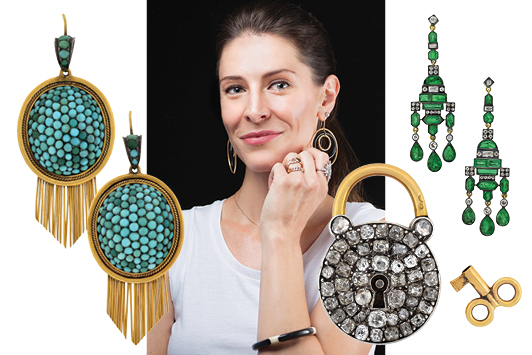
What is the best approach for developing
e-commerce for vintage jewelry?
Do your research; don’t launch until the site is 100% ready. The key is to develop an easy-to-navigate website, not necessarily high-tech or fancy, but appealing and clearly laid out for the consumer. Excellent jewelry photography and informative product descriptions are crucial. The one consistent compliment I receive about the current website that I manage is the quality of our images and descriptions. And we have found [that] excellent customer service and speedy and personalized order shipment are important assets on our website.
Is it difficult to develop online promotions for
jewelry that is one of a kind?
Yes, but not impossible. You need to have someone with a naturally creative eye who is knowledgeable when it comes to vintage jewelry [in charge of] your social media. While enticing images are incredibly important, you want to showcase what is unique and appealing to fans of vintage and contemporary jewelry alike. You need to create an “identity” for your store so a prospective customer scrolling through Instagram, Facebook, etc. will distinguish and recognize your business.
What are the most common mistakes retailers
make in this area?
The most common mistake I see is bad product images. They should be clean, well-edited, bright, in focus, and honest to the piece’s true condition. If you’re going to step into the world of e-commerce, do it right. Invest in the proper photography equipment and either learn how to use an editing program like Photoshop, or hire someone who already knows. Don’t assume just anyone within your business can or should manage social media and online promotions. You don’t necessarily need to hire an outside company, but it needs to be someone with a creative mind when it comes to photography and design.
You may have amazing jewelry, but don’t assume people will automatically be able to see it or find you online. It takes some time to build a following, and it takes an incredible amount of advertising, specifically with search engines
like Google. Probably the most important online tool, search-engine marketing is also likely the most costly.
What other e-tools have you found helpful?
We have found developing a strong social media presence that is consistently updated is key. Consistency is very important when it comes to the effectiveness of blogs. If you’re unilaterally running an e-commerce business, regularly developing a blog post often falls to the wayside. I have found that a more effective approach is to work with or become acquainted with the several vintage jewelry bloggers already out there. There are some really great ones who just do it because of their true passion for anything jewelry.
Another great e-tool is third-party websites, which are basically a collection of retailers selling antique and vintage jewelry and collectibles. These can make it easier for dealers and retailers to have their product online without the commitment of an actual website. If you already have an e-commerce site, these websites offer a good way to spread your name while selling product. But keep in mind, depending on the third-party site, you are responsible for membership, selling and listing fees.
Images:Emily Feehery; Kate Karlsen
Article from the Rapaport Magazine - September 2020. To subscribe click here.